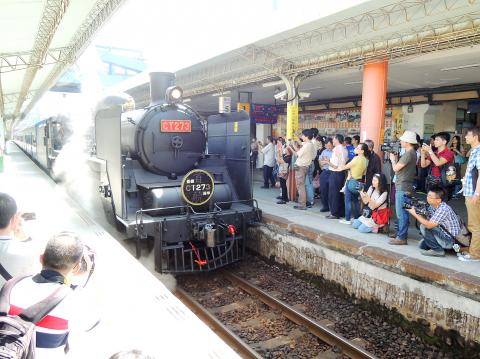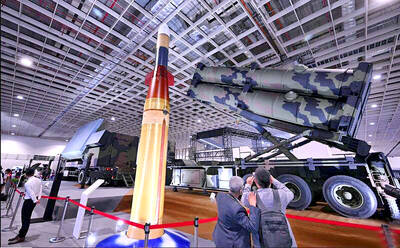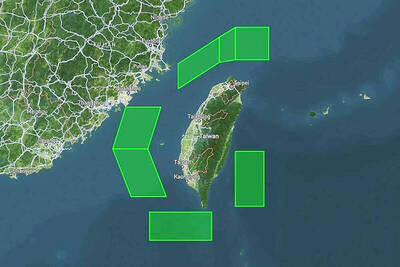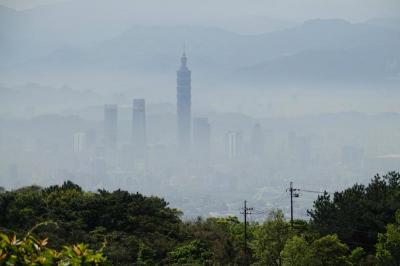A CT273-model steam locomotive, which had not seen active duty for 35 years carried passengers again yesterday as part of celebrations of the 127th anniversary of the founding of the precursor to the Taiwan Railways Administration (TRA).
With the whistle blowing and white smoke puffing out of its smokestack, the “Queen of the Steam Locomotives,” led a four-carriage train into the Changhwa Railway Station at 9am. Passengers and railway enthusiasts on the platform captured the moment on their cameras and mobile phones.
The 240 seats on the train for a trip between Changhwa and Ershui (二水) quickly sold out when they went on sale online last month.

Photo: Wu Wei-kung, Taipei Times
Driver Liu Ken-yueh (劉耿岳) said the train was powered by the steam generated by burning coal, adding that the coal burner was right next to the driver.
“The temperature was quite high, and you really have to be able to bear it in the summertime,” Liu said, his clothes drenched in sweat. “Compared with electrical-powered trains, operating a steam train consumes a lot more of your strength.”
The locomotive was manufactured by Kawasaki Heavy Industries in 1943. It was used for the trains running between Taipei and Kaohsiung, and had a top speed of 85kph, making it the fastest train in service at the time.
The TRA stopped using the locomotive in 1979 and removed it from active duty in 1984.
In 1993, the Taiwan Folk Village (台灣民俗村) leased the locomotive to put it on display in the park. However, it failed to return the locomotive after its lease expired in 2008.
The TRA recovered the locomotive from the park in 2010 and placed it in the fan-shaped train depot in Changhwa.
Taipei Depot director Hong Chin-hsing (洪進興) said the locomotive was in a bad shape when the agency recovered it.
“Many of parts were rusty, and we had to tear down the locomotive to repair it,” Hong said. “Some of the parts were beyond repair and we had to redo them. The restoration of CT-273 was the most complicated and difficult task we have done.”
The TRA spent a little over two years restoring the locomotive so that it could become operational again, inviting retired technician Liu Shu-ken (劉樹根), 81, to supervise the restoration work, Hong said.
Liu has also helped restore CK124 and CK101-model locomotives.
The retiree stood with the drivers in the driver’s cabin yesterday to ensure that the locomotive was operating correctly.
The rare opportunity to see a steam locomotive in action drew many railway fans, including 11-year-old Yang Hao-yu (楊皓宇) and his family.
“I may not have the chance to board the train again if I miss today,” Yang said.
This year marks the 127th anniversary of the start of construction of a railway line between Keelung and Taipei in 1887. The line was extended during Japanese colonial rule by the Ministry of Taiwan Railway between Keelung and present-day Greater Kaohsiung, with construction finishing in April 1908.
The TRA was established in 1945 following the end of World War II and the end of the Japanese colonial era.
Meanwhile, a TRA employee in Hualian, Yang Chao-shun (楊朝順), was named an exemplary employee for his record of not taking a single day of leave — even for illness — in 24 years.
He has coordinated train times and operated switch machines and control signals at Heren Station, a cargo shipment station, since he joined the TRA in 1989.
Heren has the highest cargo transport volume of any TRA station at 13,000 tonnes a day, according to Hualien operations section boss Chang Chien-li (張建曆), who said the station has suffered from a lack of personnel on top of its heavy workload.
“Staff at the station have not had time for breaks, but Yang Chao-shun has not ever asked for leave, not even for one day,” Chang said.
Additional reporting by staff writer and CNA

Taiwan is to commence mass production of the Tien Kung (天弓, “Sky Bow”) III, IV and V missiles by the second quarter of this year if the legislature approves the government’s NT$1.25 trillion (US$39.78 billion) special defense budget, an official said yesterday. Commenting on condition of anonymity, a defense official with knowledge of the matter said that the advanced systems are expected to provide crucial capabilities against ballistic and cruise missiles for the proposed “T-Dome,” an advanced, multi-layered air defense network. The Tien Kung III is an air defense missile with a maximum interception altitude of 35km. The Tien Kung IV and V

The disruption of 941 flights in and out of Taiwan due to China’s large-scale military exercises was no accident, but rather the result of a “quasi-blockade” used to simulate creating the air and sea routes needed for an amphibious landing, a military expert said. The disruptions occurred on Tuesday and lasted about 10 hours as China conducted live-fire drills in the Taiwan Strait. The Civil Aviation Administration (CAA) said the exercises affected 857 international flights and 84 domestic flights, affecting more than 100,000 travelers. Su Tzu-yun (蘇紫雲), a research fellow at the government-sponsored Institute for National Defense and Security Research, said the air

A strong continental cold air mass is to bring pollutants to Taiwan from tomorrow, the Ministry of Environment said today, as it issued an “orange” air quality alert for most of the country. All of Taiwan except for Hualien and Taitung counties is to be under an “orange” air quality alert tomorrow, indicating air quality that is unhealthy for sensitive groups. In China, areas from Shandong to Shanghai have been enveloped in haze since Saturday, the ministry said in a news release. Yesterday, hourly concentrations of PM2.5 in these areas ranged from 65 to 160 micrograms per cubic meter (mg/m³), and pollutants were

Taiwan’s armed forces have established response protocols for a wide range of sudden contingencies, including the “Wan Chun Plan” to protect the head of state, the Ministry of Defense (MND) said today. After US President Donald Trump on Saturday launched a series of airstrikes in Venezuela and kidnapped Venezuelan President Nicolas Maduro, concerns have been raised as to whether China would launch a similar “decapitation strike” on Taiwan. The armed forces regularly coordinate with relevant agencies and practice drills to ensure preparedness for a wide range of scenarios, Vice Minister of National Defense Hsu Szu-chien (徐斯儉) told reporters before a